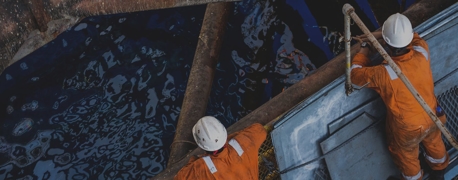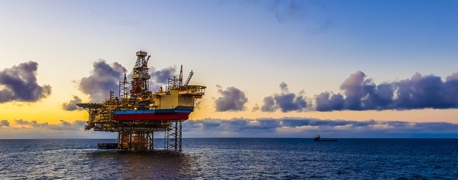Aging Cargo Ships: Challenges, Risks & Responsibilities

The captain of the SS El Faro yawned. “Oh, look at that red sky over there,” he said as he looked out upon the horizon. “Red in the morning, sailors take warning.”
This was logged by the vessel’s voyage data recorder (VDR) at 6:41 a.m. on September 30, 2015, as the 40-year-old cargo ship steamed on her regular route from Jacksonville, Florida, to San Juan, Puerto Rico.
El Faro sank the following morning after sailing directly into Hurricane Joaquin.
None of her crew of 33 survived.
Nearly a year later, after a third undersea mission to locate the wreckage and retrieve El Faro’s VDR, which was found 15,250 feet below the ocean’s surface, the National Transportation Safety Board (NTSB), in coordination with the U.S. Navy and other organizations, was able to pull together 26 hours of data and audio files. This information, along with thousands of pictures of the wreckage and an analysis of El Faro’s sister ship, El Yunque, painted a clear picture of what went wrong.
The NTSB’s accident report detailed numerous safety issues that contributed to the loss of the vessel and her entire crew, several of which had to do with El Faro’s seaworthiness. Flooding in cargo holds, loss of propulsion, downflooding through ventilation closures, and lack of appropriate survival craft were all listed in the report, as well as the use of outdated weather information, inadequate company oversight, and an insufficient safety management system.
El Faro was not equipped to make it through a storm like Joaquin. Using limited access to weather information and outdated navigation equipment, the vessel steamed straight into the eyewall of the hurricane, the most destructive part of the storm.
On October 1 at 7:30 a.m., the VDR recorded the captain saying, “Bow is down, bow is down.” He ordered the vessel’s life rafts thrown overboard and for the crew to enter them, but seven minutes later, he was recorded asking, “Where are the life preservers on the bridge?”
At 7:38 a.m., an able seamen yelled, “Goin’ down!”
The captain replied, “You’re not goin’ down. Come on.”
At 7:39 a.m., the seaman said loudly, “I’m gone.”
The captain yelled back, “No you’re not.”
About 30 seconds later, a low-frequency rumble began. The captain called the seaman’s name and yelled, “It’s time to come this way.”
A few seconds later, at 7:39:41.8 a.m., the recording ended.
The Age Crisis in Maritime Commerce
The global economy depends on the seamless flow of goods across the world’s oceans. Maritime commerce is a multi-billion-dollar industry, with ships transporting an estimated 80% of goods worldwide. It is a growing industry as well, with the volume of cargo transported by maritime vessels more than doubling from 4 to nearly 11 billion tons between 1990 and 2021.
For all its growth and progress, however, maritime commerce relies heavily on aging vessels. According to the International Maritime Organization (IMO), the average age of commercial cargo vessels is more than 20 years. According to BIMCO’s October 2023 report, nearly 21% of the world’s containerships are over 20 years old, but carriers are slow to scrap older ships—a mere 0.8% of the fleet was set to be retired that same year.
Older cargo vessels, having braved the seas for decades, often bear the scars of their service in the form of wear and tear, corrosion, and outdated technology, which can compromise their seaworthiness and the safety of their crews. The loss of El Faro, which was built in 1975, is an example of this. When aging cargo vessels are improperly maintained or negligently operated, crews will pay the price—sometimes with their lives.
The lifespan of a cargo ship, while theoretically extending 25 to 30 years with diligent maintenance, is frequently undercut by the ravages of time and the relentless demands of commercial exploitation. Corrosion eats away at hulls, mechanical parts wear down, and the absence of modern safety measures like advanced fire suppression systems and navigation aids becomes increasingly pronounced. Such deficiencies not only elevate the risk of catastrophic failure but also place these vessels at a competitive disadvantage in an era where technological advancements are rapidly reshaping maritime operations.
For the crews who man these aging ships, the dangers are all too real. El Faro may have ultimately sunk because she was caught in a Category 4 hurricane, but her loss was preventable. TOTE Maritime, the owner of the doomed cargo vessel, claimed she was well-maintained, but a former crew member said otherwise, stating “It was a rust bucket…that ship wasn’t supposed to be on the water.” Other ex-crew members spoke of seeing rust everywhere, a cook’s room that leaked, and even holes in the ship’s deck.
Vessel owners and operators must take appropriate measures to ensure the seaworthiness of their cargo ships; this is even more important as vessels age. The challenge of ensuring the fitness of older vessels can be daunting, but it is an unshakable responsibility that maritime companies must uphold.
Why Are Old Cargo Ships Still in Operation?
Aging cargo vessels remain on the world’s oceans for various reasons:
- Cost-Effectiveness: Older ships, having amortized their initial purchase price over many years, can be cheaper to operate in terms of capital costs. This makes them financially attractive for certain routes or operations where cutting-edge technology or speed is not the primary concern.
- Market Dynamics: The demand for shipping fluctuates with global trade volumes. During periods of high demand, older vessels may be kept in service to meet capacity needs, even if they are less efficient than newer models. Conversely, in downturns, they can operate on routes where their lower operational speed and efficiency are less of a disadvantage.
- Retrofitting and Upgrades: Some shipowners opt to retrofit older vessels with new technologies to extend their operational life. This can be a cost-effective way to comply with newer environmental regulations and improve efficiency without incurring the high costs of new builds.
- Regulatory Compliance: While international and national regulations set standards for vessel safety and environmental performance, ships are often grandfathered under the rules that were in effect at the time of their construction. Compliance with newer regulations can typically be achieved through retrofitting, allowing these older vessels to continue operating.
Using older cargo ships is often considered a cost-saving option over investing in new ones, which makes the decision to retire and replace them difficult. The costs and environmental concerns related to dismantling old ships add to these challenges. Nevertheless, allowing these vessels to continue operating, especially those that barely meet safety requirements, poses a significant risk to maritime safety.
Problems That Age Cargo Ships Faster
Propulsion loss incidents like what happened to the El Faro aren’t exclusive to older cargo ships. While rare, recently manufactured vessels also suffer from propulsion loss, with equally tragic results.
For instance, in March 2024, a shipping container vessel named The Dali suffered loss of propulsion, colliding into and collapsing the Francis Scott Key Bridge in Baltimore. Eight people were on the bridge as it fell into the water, but only two were immediately rescued. The Dali was built in 2015, making it less than 10 years old at the time of the incident.
A contributing factor to propulsion loss and cargo ship engine failure is fuel quality. “Off-spec fuel,” or fuel that has a different density from what a cargo vessel was designed to use, can create fuel pressure problems that damage fuel injection systems, block fuel filters, and ultimately incapacitate engines. With off-spec fuel, total engine failure isn’t decades away—it’s potentially just a few years away.
Recognizing the complexities of this issue, international bodies like the International Maritime Organization (IMO) have advocated for more stringent standards and oversight, pushing for the modernization of fleets and the adoption of sustainable practices in ship recycling. Yet, the path forward is fraught with regulatory, economic, and technical challenges.
As the maritime industry grapples with these issues, the lessons of El Faro and other maritime disasters loom large. Vessel owners and operators must commit to rigorous maintenance, upgrades, and, when necessary, the decommissioning of outdated vessels, if we can hope to safeguard the lives of those who man the world’s cargo ships.


